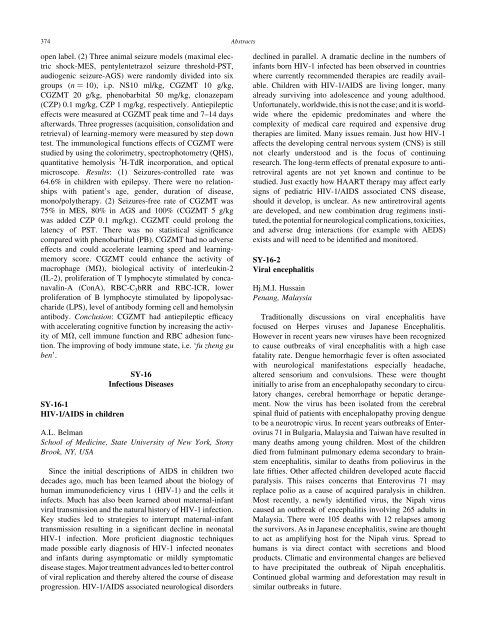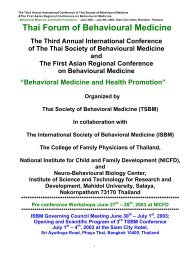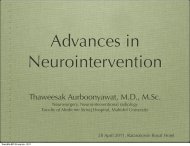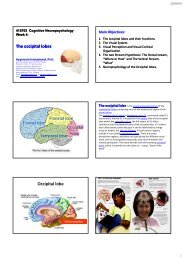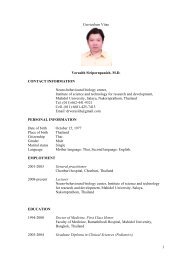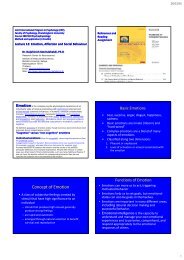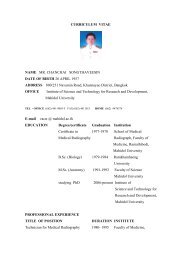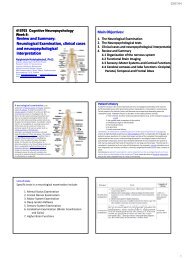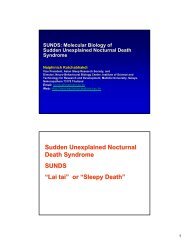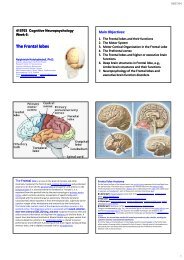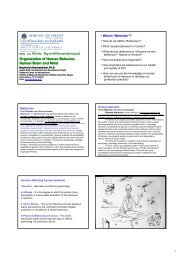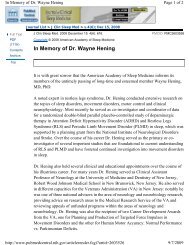PDF File - Mahidol University
PDF File - Mahidol University
PDF File - Mahidol University
You also want an ePaper? Increase the reach of your titles
YUMPU automatically turns print PDFs into web optimized ePapers that Google loves.
374<br />
Abstracts<br />
open label. (2) Three animal seizure models (maximal electric<br />
shock-MES, pentylentetrazol seizure threshold-PST,<br />
audiogenic seizure-AGS) were randomly divided into six<br />
groups (n ¼ 10), i.p. NS10 ml/kg, CGZMT 10 g/kg,<br />
CGZMT 20 g/kg, phenobarbital 50 mg/kg, clonazepam<br />
(CZP) 0.1 mg/kg, CZP 1 mg/kg, respectively. Antiepileptic<br />
effects were measured at CGZMT peak time and 7–14 days<br />
afterwards. Three progresses (acquisition, consolidation and<br />
retrieval) of learning-memory were measured by step down<br />
test. The immunological functions effects of CGZMT were<br />
studied by using the colorimetry, spectrophotometry (QHS),<br />
quantitative hemolysis 3 H-TdR incorporation, and optical<br />
microscope. Results: (1) Seizures-controlled rate was<br />
64.6% in children with epilepsy. There were no relationships<br />
with patient’s age, gender, duration of disease,<br />
mono/polytherapy. (2) Seizures-free rate of CGZMT was<br />
75% in MES, 80% in AGS and 100% (CGZMT 5 g/kg<br />
was added CZP 0.1 mg/kg). CGZMT could prolong the<br />
latency of PST. There was no statistical significance<br />
compared with phenobarbital (PB). CGZMT had no adverse<br />
effects and could accelerate learning speed and learningmemory<br />
score. CGZMT could enhance the activity of<br />
macrophage (MV), biological activity of interleukin-2<br />
(IL-2), proliferation of T lymphocyte stimulated by concanavalin-A<br />
(ConA), RBC-C 3 bRR and RBC-ICR, lower<br />
proliferation of B lymphocyte stimulated by lipopolysaccharide<br />
(LPS), level of antibody forming cell and hemolysin<br />
antibody. Conclusion: CGZMT had antiepileptic efficacy<br />
with accelerating cognitive function by increasing the activity<br />
of MV, cell immune function and RBC adhesion function.<br />
The improving of body immune state, i.e. ‘fu zheng gu<br />
ben’.<br />
SY-16-1<br />
HIV-1/AIDS in children<br />
SY-16<br />
Infectious Diseases<br />
A.L. Belman<br />
School of Medicine, State <strong>University</strong> of New York, Stony<br />
Brook, NY, USA<br />
Since the initial descriptions of AIDS in children two<br />
decades ago, much has been learned about the biology of<br />
human immunodeficiency virus 1 (HIV-1) and the cells it<br />
infects. Much has also been learned about maternal-infant<br />
viral transmission and the natural history of HIV-1 infection.<br />
Key studies led to strategies to interrupt maternal-infant<br />
transmission resulting in a significant decline in neonatal<br />
HIV-1 infection. More proficient diagnostic techniques<br />
made possible early diagnosis of HIV-1 infected neonates<br />
and infants during asymptomatic or mildly symptomatic<br />
disease stages. Major treatment advances led to better control<br />
of viral replication and thereby altered the course of disease<br />
progression. HIV-1/AIDS associated neurological disorders<br />
declined in parallel. A dramatic decline in the numbers of<br />
infants born HIV-1 infected has been observed in countries<br />
where currently recommended therapies are readily available.<br />
Children with HIV-1/AIDS are living longer, many<br />
already surviving into adolescence and young adulthood.<br />
Unfortunately, worldwide, this is not the case; and it is worldwide<br />
where the epidemic predominates and where the<br />
complexity of medical care required and expensive drug<br />
therapies are limited. Many issues remain. Just how HIV-1<br />
affects the developing central nervous system (CNS) is still<br />
not clearly understood and is the focus of continuing<br />
research. The long-term effects of prenatal exposure to antiretroviral<br />
agents are not yet known and continue to be<br />
studied. Just exactly how HAART therapy may affect early<br />
signs of pediatric HIV-1/AIDS associated CNS disease,<br />
should it develop, is unclear. As new antiretroviral agents<br />
are developed, and new combination drug regimens instituted,<br />
the potential for neurological complications, toxicities,<br />
and adverse drug interactions (for example with AEDS)<br />
exists and will need to be identified and monitored.<br />
SY-16-2<br />
Viral encephalitis<br />
Hj.M.I. Hussain<br />
Penang, Malaysia<br />
Traditionally discussions on viral encephalitis have<br />
focused on Herpes viruses and Japanese Encephalitis.<br />
However in recent years new viruses have been recognized<br />
to cause outbreaks of viral encephalitis with a high case<br />
fatality rate. Dengue hemorrhagic fever is often associated<br />
with neurological manifestations especially headache,<br />
altered sensorium and convulsions. These were thought<br />
initially to arise from an encephalopathy secondary to circulatory<br />
changes, cerebral hemorrhage or hepatic derangement.<br />
Now the virus has been isolated from the cerebral<br />
spinal fluid of patients with encephalopathy proving dengue<br />
to be a neurotropic virus. In recent years outbreaks of Enterovirus<br />
71 in Bulgaria, Malaysia and Taiwan have resulted in<br />
many deaths among young children. Most of the children<br />
died from fulminant pulmonary edema secondary to brainstem<br />
encephalitis, similar to deaths from poliovirus in the<br />
late fifties. Other affected children developed acute flaccid<br />
paralysis. This raises concerns that Enterovirus 71 may<br />
replace polio as a cause of acquired paralysis in children.<br />
Most recently, a newly identified virus, the Nipah virus<br />
caused an outbreak of encephalitis involving 265 adults in<br />
Malaysia. There were 105 deaths with 12 relapses among<br />
the survivors. As in Japanese encephalitis, swine are thought<br />
to act as amplifying host for the Nipah virus. Spread to<br />
humans is via direct contact with secretions and blood<br />
products. Climatic and environmental changes are believed<br />
to have precipitated the outbreak of Nipah encephalitis.<br />
Continued global warming and deforestation may result in<br />
similar outbreaks in future.


